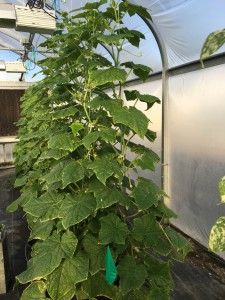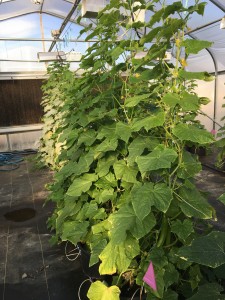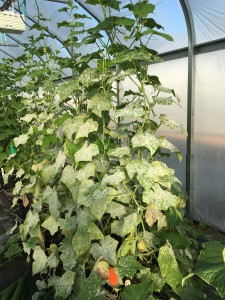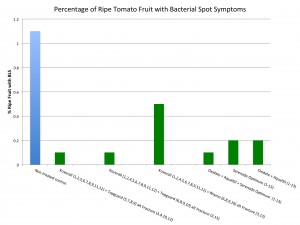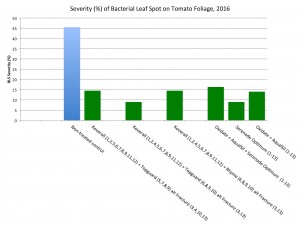Our 2016 final report on field research trials conducted in 2016 can be accessed here:plantpathologyseriesno-146. The hot dry weather for most of the summer of 2016, followed by a wet, fairly warm late summer/early autumn, created some challenges, but we have different sorts of challenges every year! One advantage of low to moderate amounts of rainfall, compared to the deluges we experienced in northern Ohio in previous summers, is that bacterial leaf spot pressure in tomatoes was not overwhelming, and we could see some product effects. The high temperatures were very favorable (too favorable) for Phytophthora blight in squash, and really put those products to the test. The weather didn’t matter for our trial for powdery mildew control in greenhouse cucumbers – some nice results are reported. Here are some highlights:
• Fungicides to control powdery mildew in greenhouse cucumbers: Weekly treatments of Terraguard SC (8 fl oz) (left photo) and Pyriofenone 300SC (4 fl oz) (center photo) controlled powdery mildew and increased cucumber fruit yield compared to the non-treated control (right photo). There was some crop injury with the Terraguard treatment. Interestingly, powdery mildew severity remained low 2 weeks after the last treatment for both fungicides.
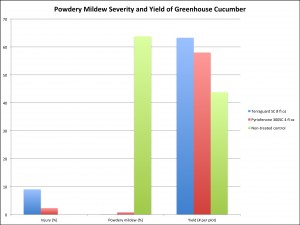
• Bioassay for sensitivity of the powdery mildew pathogen to fungicides: OSU graduate student Claudio Vrisman conducted a bioassay to evaluate the sensitivity of the powdery mildew pathogen, Podosphaera xanthii, to different fungicides in three locations in Ohio. Young squash 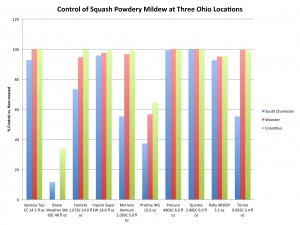 plants were produced in a greenhouse in Wooster, treated with one of the test fungicides, and placed next to pumpkin fields with plenty of powdery mildew in Wooster, South Charleston, or Columbus.
plants were produced in a greenhouse in Wooster, treated with one of the test fungicides, and placed next to pumpkin fields with plenty of powdery mildew in Wooster, South Charleston, or Columbus.
Several fungicides performed better in Wooster and Columbus than in South
Charleston (see chart – click to enlarge). Bravo Weather Stik was not effective in any location and Pristine provided only partial control in all three locations. Aprovia Top, Inspire Super, Procure, Quintec, and Rally provided >92% control in all locations. These results indicate that the efficacy of some fungicides may differ in different locations, and it is critical to manage fungicide use according to label instructions to minimize the development of fungicide insensitivity in powdery mildew pathogen populations.
• Evaluation of Orondis and other fungicides to control Phytophthora blight in squash: Squash and pumpkins are very susceptible to Phytophthora blight, which has become a widespread problem in Ohio in the last two decades. There are no commercial squash or pumpkin varieties available with a satisfactory degree of resistance to this disease, and most fungicides are also not highly effective in squash and pumpkins. The new Syngenta Crop Protection fungicide Orondis is very effective against related diseases such as late blight and downy mildew, and has shown promise against Phytophthora blight in peppers. We tested eleven different combinations of Orondis and other fungicides active against this group of pathogens. In 2016, Orondis came in three co-packs, paired with Revus (Orondis Ultra), Ridomil Gold (Orondis Gold), or Bravo (Orondis Opti) – more on new formulations for 2017 in a later post. The number of applications is limited to 33% of the total fungicide applications for Phytophthora blight, and Orondis soil applications cannot be followed by Orondis foliar applications.
 We conducted the trial in Fremont at the OSU-OARDC North Central Agricultural Experiment Station. Phytophthora blight was severe in this trial – 98% of the plants in the non-treated control were killed by August 4. As you can see in this chart (click to enlarge), none of the fungicide combinations were highly effective against Phytophthora blight. Only four treatments (green bars) significantly reduced the number of wilted/dead plants compared to the non-treated control. Although numerically a little different, there are no significant differences among these four treatments. The Orondis Gold drench does not appear to add any additional value in the control of Phytophthora blight over Orondis Ultra foliar applications alternated with Ranman or Presidio. We conducted a second trial at the OSU-OARDC Muck Crops Experiment Station in Celeryville, OH, but the disease pressure was so severe that treatment differences could not be detected. Effectively managing Phytophthora blight in squash and pumpkins will require an integrated approach that combines cultural practices such as water management and site selection (fields with low populations of the pathogen) and fungicides.
We conducted the trial in Fremont at the OSU-OARDC North Central Agricultural Experiment Station. Phytophthora blight was severe in this trial – 98% of the plants in the non-treated control were killed by August 4. As you can see in this chart (click to enlarge), none of the fungicide combinations were highly effective against Phytophthora blight. Only four treatments (green bars) significantly reduced the number of wilted/dead plants compared to the non-treated control. Although numerically a little different, there are no significant differences among these four treatments. The Orondis Gold drench does not appear to add any additional value in the control of Phytophthora blight over Orondis Ultra foliar applications alternated with Ranman or Presidio. We conducted a second trial at the OSU-OARDC Muck Crops Experiment Station in Celeryville, OH, but the disease pressure was so severe that treatment differences could not be detected. Effectively managing Phytophthora blight in squash and pumpkins will require an integrated approach that combines cultural practices such as water management and site selection (fields with low populations of the pathogen) and fungicides.
• Evaluation of products to manage bacterial spot in processing tomatoes: We conducted two bacterial spot trials in 2016 (the second one can be found at plantpathologyseriesno-146). This trial was designed to test the efficacy of several commercial products in management of bacterial spot. Since 2016 was dry for most of the summer, bacterial spot developed slowly and overall, disease pressure was moderate. Under these conditions we observed significant differences in foliar bacterial spot severity and in the percentage of fruit with bacterial spot symptoms, compared to the non-treated control (see charts below).
